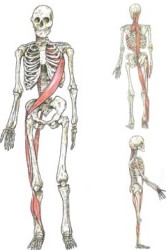 1. Chiropractic affects the autonomic nervous system, the system responsible for hormone-mediated responses and the function of the internal organs.
1. Chiropractic affects the autonomic nervous system, the system responsible for hormone-mediated responses and the function of the internal organs.
The autonomic nervous system consists of the sympathetic and parasympathetic systems. Studies demonstrating that chiropractic adjustments have a direct effect on these systems may explain why, along with pain relief, chiropractors regularly witness improvements in respiratory function, digestion, and blood pressure levels in patients beginning chiropractic care. Adjustments down-regulate the sympathetic nervous system, our flight or fight response, which is overactive in many with excessive stress. When the sympathetic nervous system is active, it causes increased heart rate, shallowed breathing, and decreased digestion in the gut, which is great in an emergency, but not where you want to live. Sympathetic overactivity is also associated with decreased immune function because one’s resources are geared toward defending against more immediate physical threats than pathogens. This may contribute to why many observe a decrease in sicknesses, like colds and flus, with chiropractic.
2. Better balance, posture, and reaction time is achieved by improving communication with the cerebellum from the joints.
The spinal cord transmits signals from the joints of the spine to the cerebellum which are processed and combined with input from the inner ear to control posture and balance. Chiropractic has been shown to improve reaction time, improve the timing of when postural muscles switch on, and improve the ability to perform tasks requiring coordination.
3. Improved joint motion allows more nutrition and hydration to be pumped to discs or joint capsules and decreases the risk of degeneration and injury.
 Whether sitting at a desk or playing sports, we don’t tend to use our muscles and joints evenly. Chronic pressure on certain joints and muscles can lead to imbalances in others, creating a long chain of joint and muscular imbalance that can eventually lead to injury. In a study on soccer players undergoing chiropractic care, it was found that chiropractic reduced the number of lower limb strains and sprains, and decreased injury recovery time and the number of weeks players missed due to injuries. Studies have also shown that chiropractic reduces the days of work missed by workers with low back pain compared to those being treated by a medical doctor, and that chiropractic is more effective than drugs for back and neck pain.
Whether sitting at a desk or playing sports, we don’t tend to use our muscles and joints evenly. Chronic pressure on certain joints and muscles can lead to imbalances in others, creating a long chain of joint and muscular imbalance that can eventually lead to injury. In a study on soccer players undergoing chiropractic care, it was found that chiropractic reduced the number of lower limb strains and sprains, and decreased injury recovery time and the number of weeks players missed due to injuries. Studies have also shown that chiropractic reduces the days of work missed by workers with low back pain compared to those being treated by a medical doctor, and that chiropractic is more effective than drugs for back and neck pain.
4. Adjustments have a regulatory effect on neurotransmitter balances and brain wave function which controls how we think, feel, and behave.
Different areas of the brain, including the hypothalamus, the substantia nigra and the amygdala, work together to help balance and regulate the production of the neurotransmitters, chemical messengers that control our state of mind. If there is a disruption in this cascade, it can lead to depression, anxiety, compulsive disorders, and addictions. When EEG scans were performed before and after patients were adjusted, they were shown to normalize the readings on brain wave maps, increasing the Alpha waves associated with a relaxed or meditative states.
5. Chiropractic can assist in a safer pregnancy.
The Webster Technique is a gentle chiropractic manipulation performed on women late in their pregnancy that is associated with a high rate of resolution of constraint or breech pregnancies. This technique balances the pelvis, and reduces the stress on the ligaments connecting the pelvis to the uterus, which has been shown to help allow the baby to shift into the proper position for birth. Chiropractic care during pregnancy has also been found to result in a more comfortable pregnancy and reduce labor times.
Resources:
Hormones: Chemical Messengers and the Chiropractic Link
The Effect of Chiropractic Care on Cerebellar Function
Effect of Chiropractic Adjustment on Brain Wave Pattern as Measured by QEEG
The Webster Technique: a chiropractic technique with obstetric implications.
